Android Studio实现连连看小游戏,比比看谁过关最快~
Posted 振华OPPO
tags:
篇首语:本文由小常识网(cha138.com)小编为大家整理,主要介绍了Android Studio实现连连看小游戏,比比看谁过关最快~相关的知识,希望对你有一定的参考价值。
项目目录
一、项目概述
这是一款基于android studio开发的连连看小游戏。主要实现的功能有:
- 难度设置
- 打乱重排
- 排行榜
- 计时器
- 背景音乐
- 消除音效
二、主要技术
主要应用的技术如下:
| Fragment碎片 | Service服务 | Menu菜单 | 自定义view | Java反射 |
|---|---|---|---|---|
| handler消息机制 | BroadcastReceiver | 多线程 | SQLiteOpenHelper | SharedPreferences |
| Bitmap | ViewPager | MediaPlayer | Dialog | ListView |
本项目几乎涵盖了Android入门级的所有知识点,适合新手练手实践。
三、开发环境
开发环境依旧是在4.2.1上进行开发的,只要你的AS是近两年从官网下载的,都是可以满足的。

三、详细设计
1、数据库
创建了一张users表来存储排行榜的数据,建表语句如下:
db.execSQL("create table users (id integer primary key,name varchar(50),time varchar(50),date varchar(50))");
与以往的数据库帮助类不同,这次并没有提前创建好数据库和表,而是在类中调用构造函数进行创建,创建之后会自动执行建表语句。因为要加上表头,所以我们在建表之后率先插入一条数据作为表头。
myDBHelper = new DataBaseHelper(this,"ranking",null,1);
db = myDBHelper.getWritableDatabase();
Cursor cursor = db.query("users", null, null, null, null, null, "time");
mData = new LinkedList<>();
mData.add(new Ranking("名次","昵称","用时(s)","上榜时间"));
游戏所有的配置采用键值对形式存储——“背景音乐”:“开”。所以使用SharedPreferences,通过读取key的value判断是否关闭音乐/音效。
sp = this.getSharedPreferences("config",MODE_PRIVATE);
if(sp.getBoolean("music",true))
mp.start();
if(!sp.getBoolean("sound",true))
sound = false;
2、排行榜
首先肯定创建排行榜的实体类,其实就是数据表的结构。类的属性、构造函数、get和set方法。
public class Ranking
private String id;
private String name;
private String time;
private String date;
public Ranking(String id, String name, String time, String date)
this.id = id;
this.name = name;
this.time = time;
this.date = date;
public String getId()
return id;
public void setId(String id)
this.id = id;
public String getName()
return name;
public void setName(String name)
this.name = name;
public String getTime()
return time;
public void setTime(String time)
this.time = time;
public String getDate()
return date;
public void setDate(String date)
this.date = date;
因为要在列表中显示排行榜,所以需要自定义适配器。然后获取数据源,创建适配器,加载适配器即可。这部分内容属于老生常谈了,就当复习一下。
/* 排行榜列表的适配器 */
public class RankingAdapter extends BaseAdapter
private LinkedList<Ranking> mData;
private Context mContext;
public RankingAdapter(LinkedList<Ranking> mData, Context mContext)
this.mData = mData;
this.mContext = mContext;
@Override
public int getCount()
return mData.size();
@Override
public Object getItem(int position)
return null;
@Override
public long getItemId(int position)
return position;
@Override
public View getView(int position, View convertView, ViewGroup parent)
convertView = LayoutInflater.from(mContext).inflate(R.layout.ranking_item,null);
TextView uid = convertView.findViewById(R.id.uid);
TextView uname = convertView.findViewById(R.id.uname);
TextView utime = convertView.findViewById(R.id.utime);
TextView udate = convertView.findViewById(R.id.udate);
uid.setText(mData.get(position).getId());
uname.setText(mData.get(position).getName());
utime.setText(mData.get(position).getTime());
udate.setText(mData.get(position).getDate());
return convertView;
3、游戏实现
因为连连看游戏是消除一个个小方块,所以最基本的游戏单元就是方块类。每个方块有哪些属性呢?首先方块上面有图片,有自己在屏幕上的左上角坐标(x,y),以及在二维数组中的一维和二维索引值。有哪些方法呢?首先必须能够判断两个Piece上的图片是否相同,不然无法进入消除判断,然后获取方块中心点坐标,用于画图。
/* 方块对象 */
public class Piece
/**
* 保存方块对象的所对应的图片
*/
private PieceImage pieceImage;
/**
* 该方块的左上角的x坐标
*/
private int beginX;
/**
* 该方块的左上角的y座标
*/
private int beginY;
/**
* 该对象在Piece[][]数组中第一维的索引值
*/
private int indexX;
/**
* 该对象在Piece[][]数组中第二维的索引值
*/
private int indexY;
/**
* 设置该Piece对象在数组中的索引值
*
* @param indexX
* 该方块的左上角的x坐标
* @param indexY
* 该方块的左上角的y座标
*/
public Piece(int indexX, int indexY)
this.indexX = indexX;
this.indexY = indexY;
/**
* 获取该Piece的中心位置
*
* @return 中心点的坐标对象Point
*/
public Point getCenter()
return new Point(getBeginX() + GameConf.PIECE_WIDTH / 2, getBeginY() + GameConf.PIECE_HEIGHT / 2);
/**
* 判断两个Piece上的图片是否相同
*
* @param otherPieceImage
* 另外的一个Piece对象
* @return 是否相同
*/
public boolean isSameImage(Piece otherPieceImage)
if (pieceImage == null)
if (otherPieceImage.pieceImage != null)
return false;
// 当两个Piece封装图片资源ID相同时,即可认为这两个Piece上的图片相同。
return pieceImage.getImageId() == otherPieceImage.pieceImage
.getImageId();
/**
* @return 该方块的左上角的X坐标
*/
public int getBeginX()
return beginX;
/**
* 设置该方块的左上角的X坐标
*
* @param beginX
*/
public void setBeginX(int beginX)
this.beginX = beginX;
/**
* @return 该方块的左上角的Y座标
*/
public int getBeginY()
return beginY;
/**
* 设置该方块的左上角的Y坐标
*
* @param beginY
*/
public void setBeginY(int beginY)
this.beginY = beginY;
/**
* @return 该对象在Piece[][]数组中第一维的索引值
*/
public int getIndexX()
return indexX;
/**
* 设置该对象在Piece[][]数组中第一维的索引值
*
* @param indexX
*/
public void setIndexX(int indexX)
this.indexX = indexX;
/**
* @return 该对象在Piece[][]数组中第二维的索引值
*/
public int getIndexY()
return indexY;
/**
* 设置该对象在Piece[][]数组中第二维的索引值
*
* @param indexY
*/
public void setIndexY(int indexY)
this.indexY = indexY;
/**
* @return 保存方块对象的所对应的图片
*/
public PieceImage getPieceImage()
return pieceImage;
/**
* 设置保存方块对象的所对应的图片
*
* @param pieceImage
*/
public void setPieceImage(PieceImage pieceImage)
this.pieceImage = pieceImage;
方块图片很简洁,两个属性分别是image位图和image的id。
/**
* 图片
*/
private Bitmap image;
/**
* 图片资源ID
*/
private int imageId;
做完这些后,我们就可以将方块放入到我们的屏幕中了,这时候定义个平板类,每次打乱方块。
protected List<Piece> createPieces(GameConf config, Piece[][] pieces)
List<Piece> notNullPieces = new ArrayList<Piece>();
for (int i = 0; i < pieces.length; i++)
for (int j = 0; j < pieces[i].length; j++)
Piece piece = new Piece(i, j);
notNullPieces.add(piece);
return notNullPieces;
我们创建了一个类用来保存连接点,方法直接调用。
private List<Point> points = new ArrayList<Point>();
获取到所有连接点后,开始在画布上画线,这样就有了动画效果。
private void drawLine(LinkInfo linkInfo, Canvas canvas)
// 获取LinkInfo中封装的所有连接点
List<Point> points = linkInfo.getLinkPoints();
// 依次遍历linkInfo中的每个连接点
for (int i = 0; i < points.size() - 1; i++)
// 获取当前连接点与下一个连接点
Point currentPoint = points.get(i);
Point nextPoint = points.get(i + 1);
// 绘制连线
canvas.drawLine(currentPoint.x, currentPoint.y, nextPoint.x,
nextPoint.y, this.paint);
最后在主碎片上面设置游戏中的逻辑,篇幅比较长,代码也比较简单,大家可以直接阅读源码学习。
// 初始化游戏失败的对话框
lostDialog = createDialog("GAME OVER", "游戏失败!请重新开始", R.drawable.lost)
.setPositiveButton("确定", new DialogInterface.OnClickListener()
public void onClick(DialogInterface dialog, int which)
startGame(0);
);
// 初始化游戏胜利的对话框
successDialog = createDialog("Success", "你真厉害!请输入你的大名!",
R.drawable.success).setView(et).setPositiveButton("确定",
new DialogInterface.OnClickListener()
public void onClick(DialogInterface dialog, int which)
String input = et.getText().toString();
myDBHelper = new DataBaseHelper(getContext(),"ranking",null,1);
db = myDBHelper.getWritableDatabase();
Time t=new Time();
t.setToNow();
int year = t.year;
int month = t.month+1;
int day = t.monthDay;
String date = year+"/"+month+"/"+day;
ContentValues cv = new ContentValues();
cv.put("name",input);
cv.put("time",String.valueOf(gameTime));
cv.put("date",date);
db.insert("users",null,cv);
Intent intent = new Intent();
intent.setAction("top.ysccx.broadcast");
intent.putExtra("name",input);
intent.putExtra("time",String.valueOf(gameTime));
getActivity().sendBroadcast(intent);
startActivity(new Intent(getActivity(),RankingActivity.class));
);
四、运行演示
1、Build项目,运行到模拟器中,可以看到默认碎片显示游戏界面,底部导航栏和顶部菜单栏。
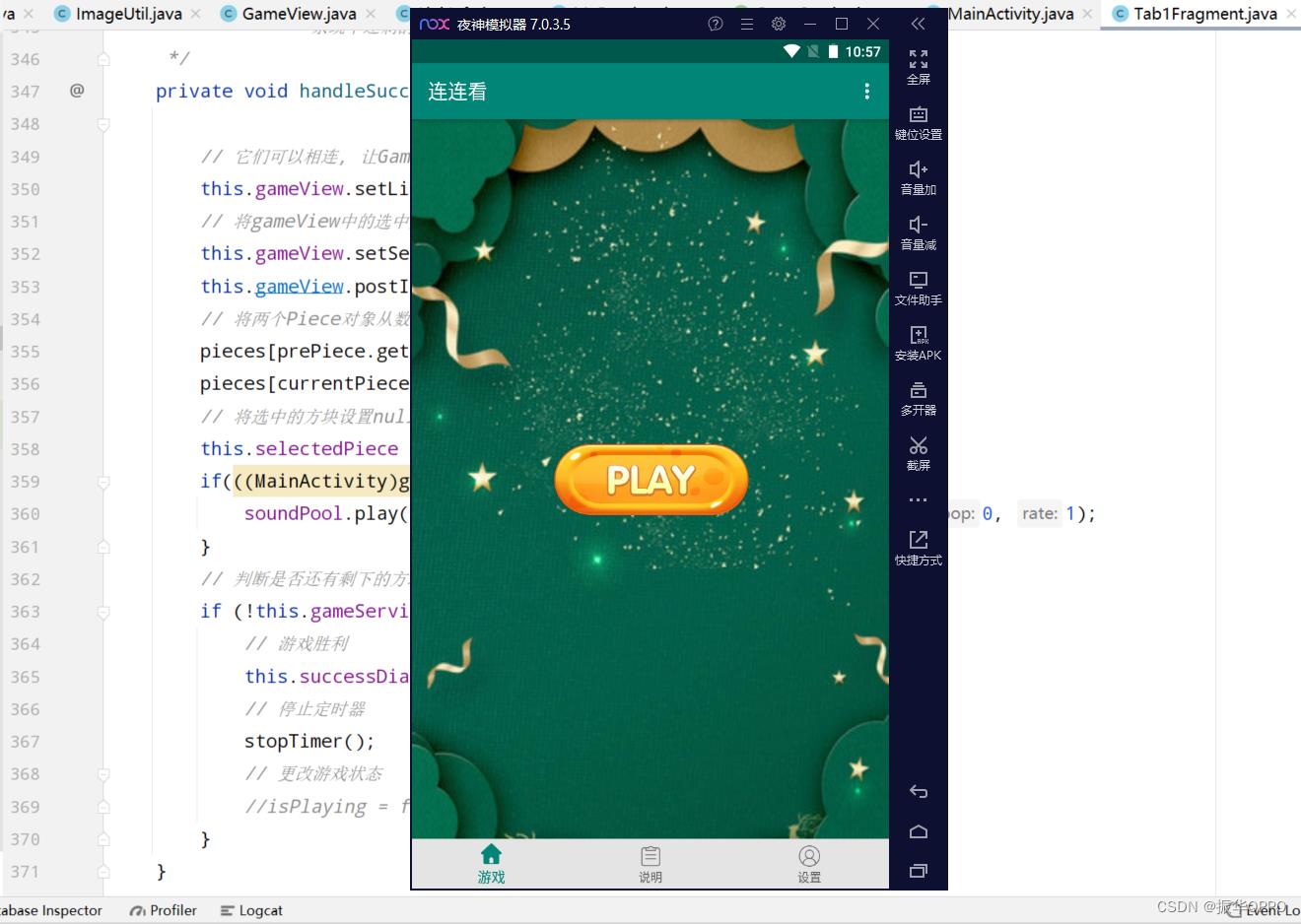
2、我们点击右上角的下拉菜单,有难度、排行榜、打乱重排、重新开始和退出五个选项。
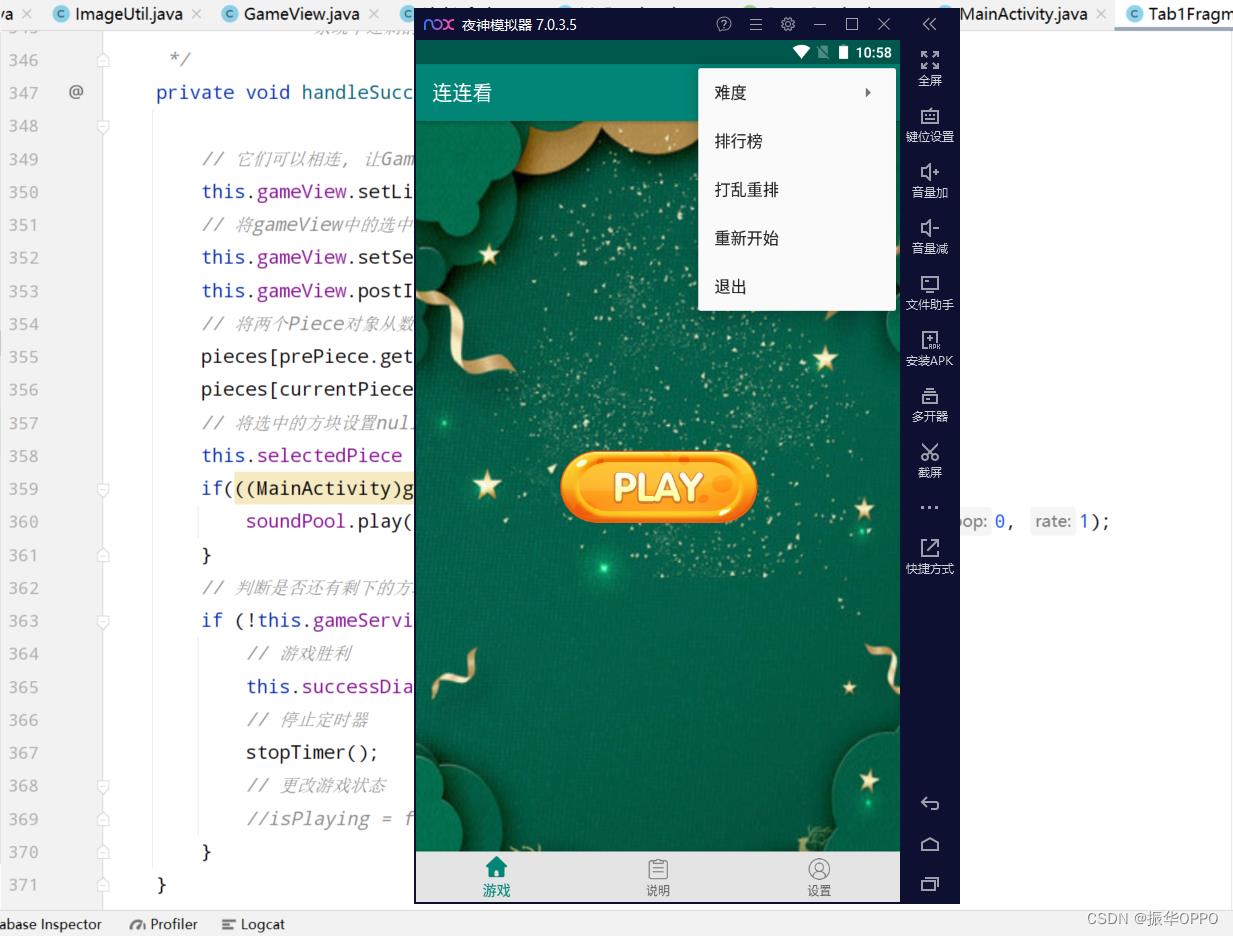
3、在难度菜单项中还有子菜单,从简单和地狱的难度,满足你的一切渴望。
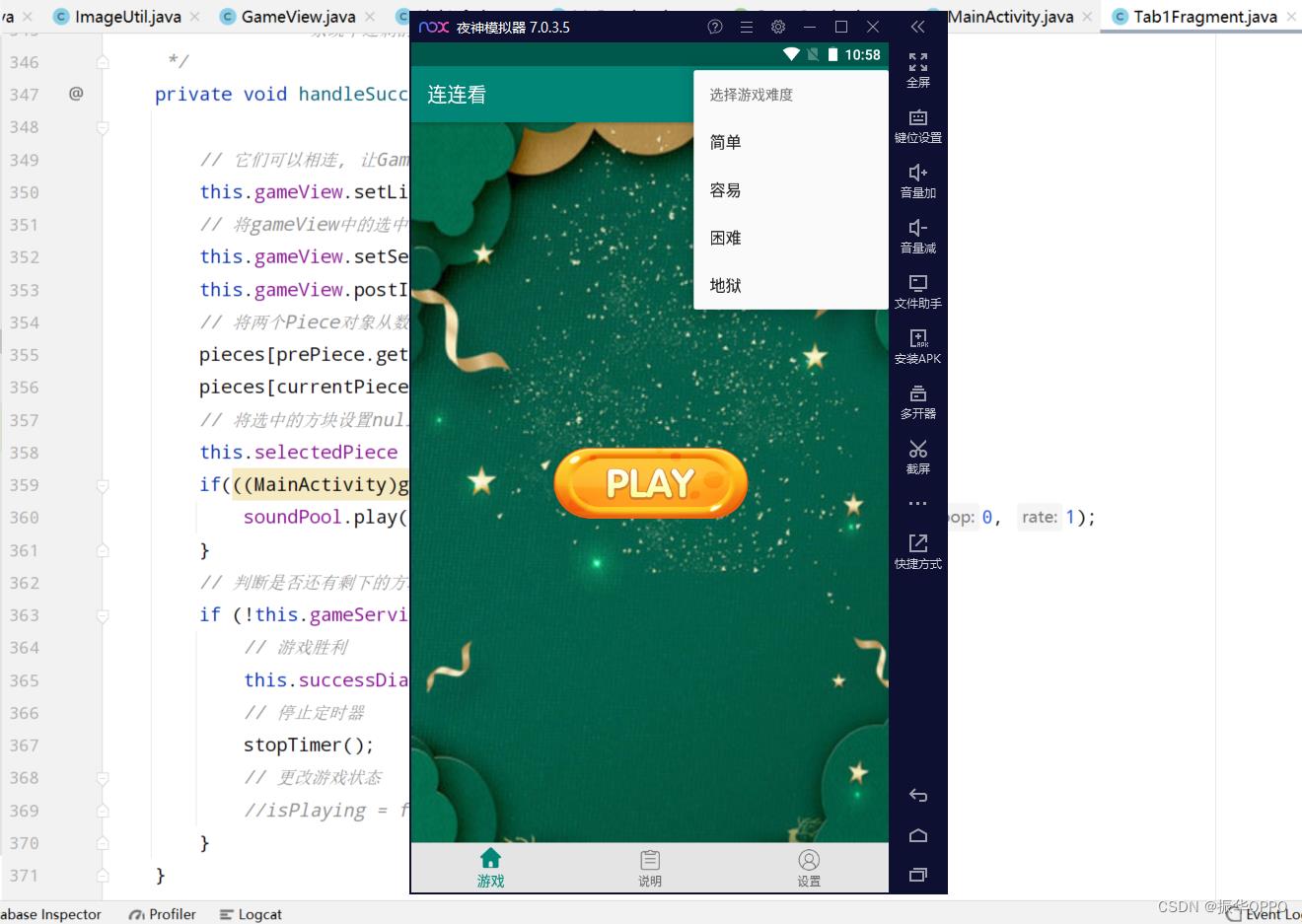
4、我们先选择简单难度,然后点击Play,游戏开始,方块随机排列在屏幕上,底部是计时。

5、然后进行消除,消除时候有背景音乐和音效,消除会有动画。
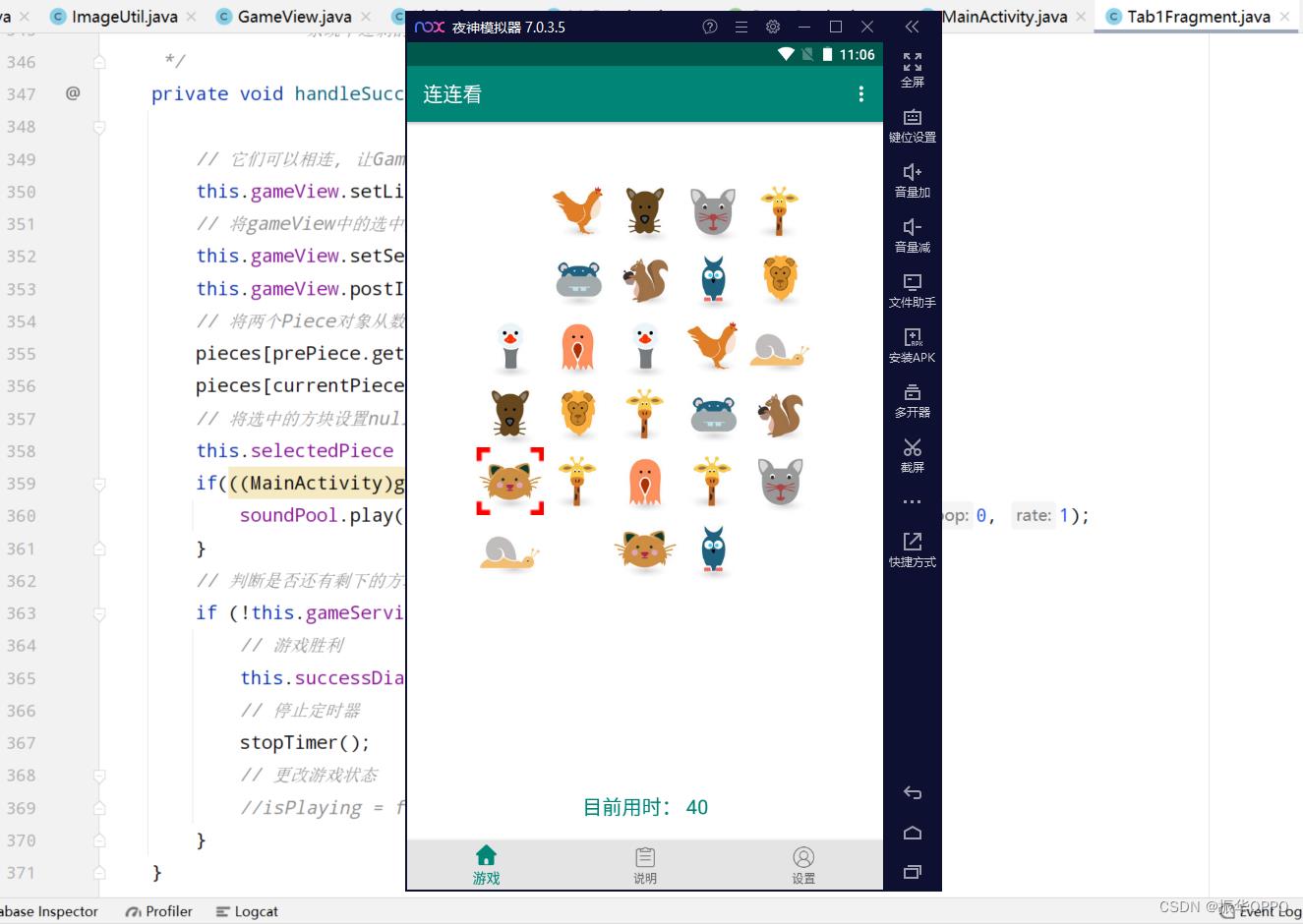
6、消除成功后弹出对话框,输入昵称用来排行。
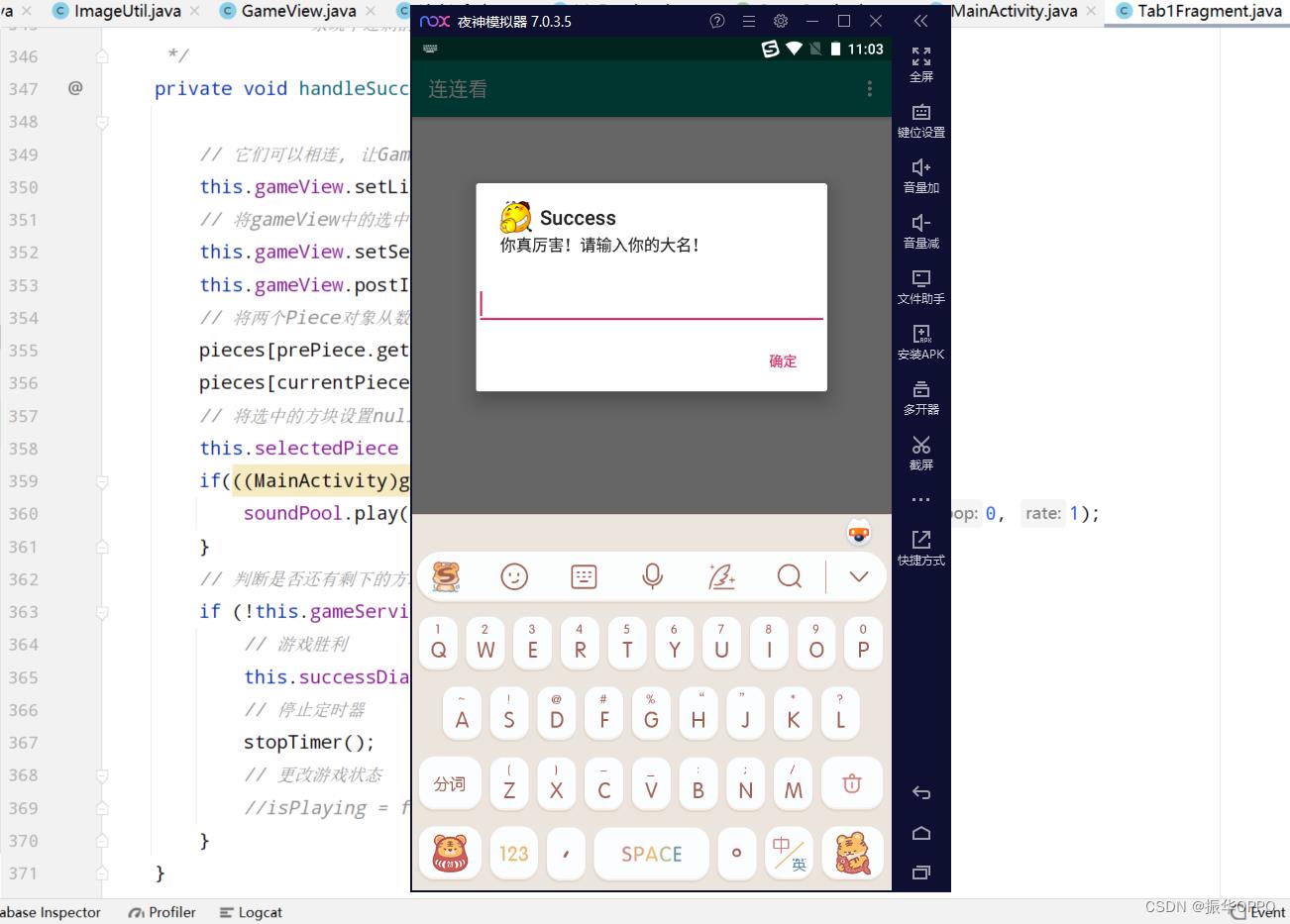
7、输入昵称可以自动跳转到排行榜,也可以点击菜单栏查看排行榜。
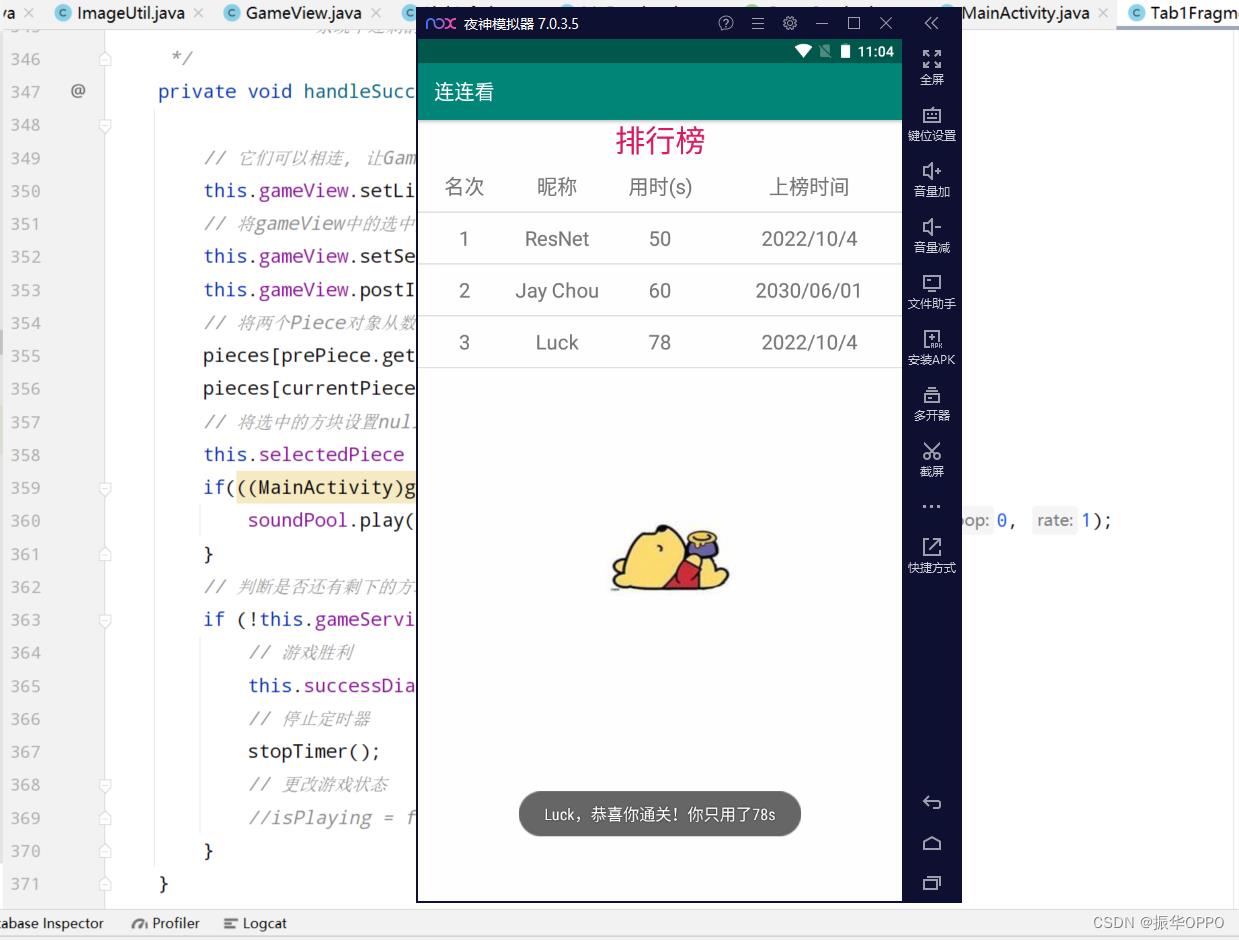
8、如果消除时候遇到死局,可以在菜单栏选择【打乱重排】,然后就会随机打乱剩余的方块。

9、玩的不满意了就重新开始,也都没有问题的。

10、我们点击导航栏的说明,可以看到游戏说明,原来是周杰伦制作的游戏啊(因为我非常喜欢周杰伦)。

11、在设置导航栏中可以选择打开音乐或者音效。

五、源码获取
源码整理好之后,会将链接放在此处,点击3连不迷路,我们下期再见!
以上是关于Android Studio实现连连看小游戏,比比看谁过关最快~的主要内容,如果未能解决你的问题,请参考以下文章